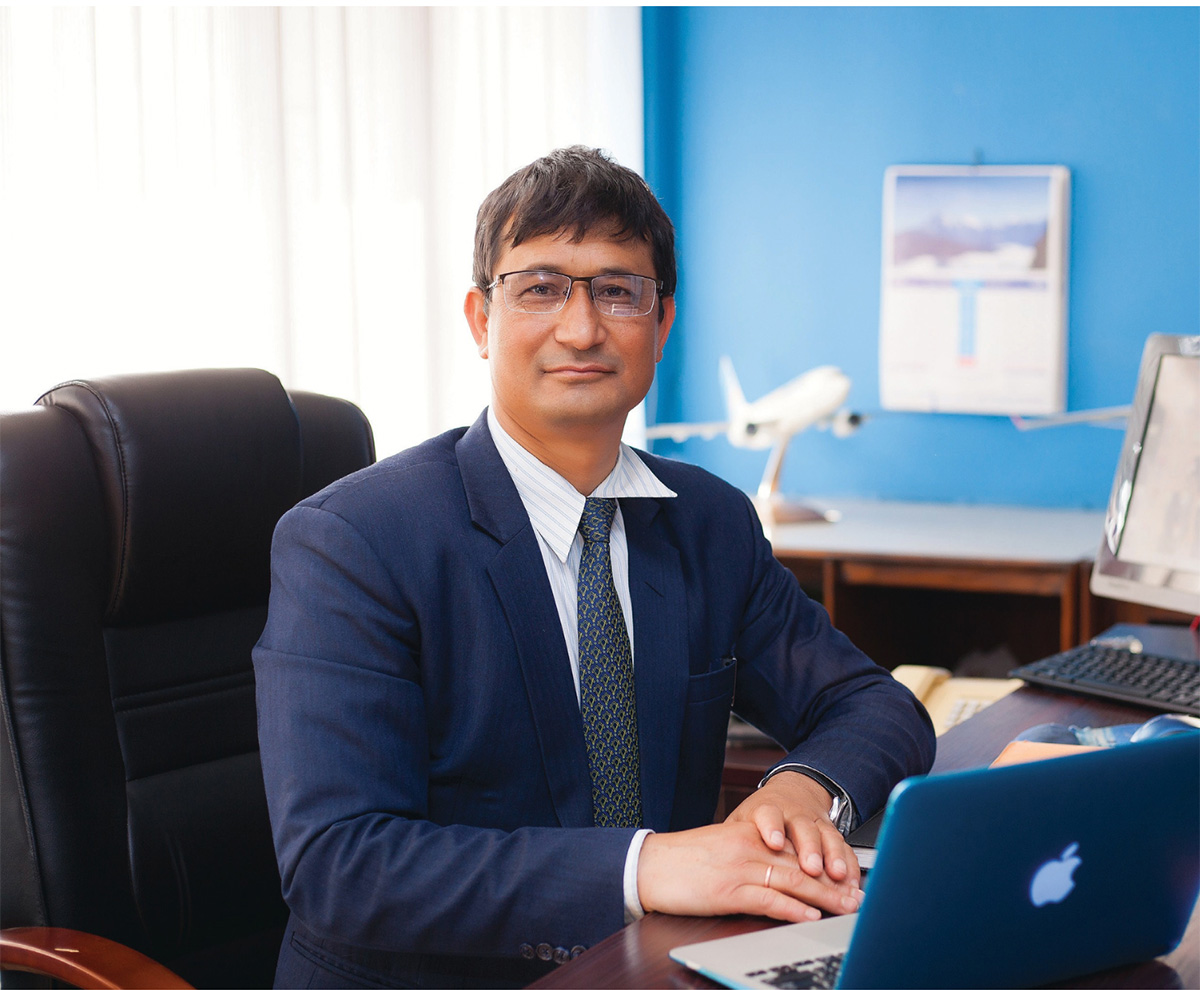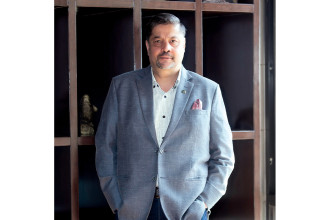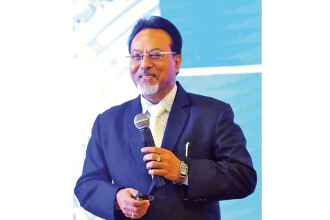
Sanjiv Gautam is the Director General at Civil Aviation Authority of Nepal (CAAN) since 2015. One of his biggest achievements since joining office was removing the tag of Significant Safety Concerns put on Nepal’s aviation sector by the International Civil Aviation Organisation (ICAO), the global aviation watchdog. B360 interviewed Gautam to ask him about the current status of the on-plan international airports in Bhairahawa, Pokhara and Nijgadh, the air entry points from India, EU’s significant safety concern list and how these issues will affect Visit Nepal 2020 campaign. Excerpts:
The Government of Nepal has declared Visit Nepal 2020, how do you think the existing status of the only international airport TIA will support this campaign?
I agree that TIA is congested. The reason being that Nepal has just one international airport and there is an increase in the number of people taking inbound and outbound flights. This is not just because of increase in tourists, but because Nepalis are now frequently using air transportation especially for labour migration and leisure. To address this issue, we are planning to rehabilitate TIA’s runway. The existing runway will be inlayed so that the existing problems can be solved for the long term. This project is scheduled to come into operation from April to June 2019.
After the rehabilitation of the TIA runway, we are planning to open TIA for 24 hours. This will help bring in more tourists to Nepal. Besides this, we are also planning to have an end-to-end taxiway which will increase the capacity of the existing traffic system. The terminal building is also being expanded. Probably within August 2019, we will be expanding the terminal to be able to cater to more people in the international airport.
The rehabilitation of TIA runway and expansion of the terminal building will help to accommodate around 10 million passengers. This year until now, we have been able to accommodate six million passengers combining both domestic and international travellers.
Four international parking bays are also under construction at TIA which will probably be completed by June 2019. Due to unavailability of parking bays, there is congestion in the air. After the completion of the parking bays, we will be accommodating almost 13 aircrafts at a time which will help decrease congestion. Besides this, we have developed a plan of air traffic flow and slot management to disseminate the traffic in peak and lean hours. The lean hours are especially in the evening between 4-8 pm. In these hours, we are trying to bring in new airlines which want to come into Nepal. This will help distribute traffic and decrease congestion.
Besides TIA, we also have Gautam Buddha International Airport. We are planning to bring this airport into operation by August 2019 to target the Visit Nepal Year 2020.
Experts suggest that Pokhara International Airport cannot support big planes. Could you explain?
The Pokhara International Airport is scheduled to be completed by July 2021. Yes, the airport is not designed for very big aircrafts. The length of the runway is 2.5 kms and is designed to handle aircrafts like Boeing 757. If we look at the air traffic flow throughout the world, almost 80% of the market is occupied by Airbus A320 and Boeing 757 which can be landed at Pokhara International Airport. So, the argument that Pokhara International Airport will not be able to host international flights is just a baseless rumour. In the next 20 years, almost 40,000 new aircrafts are coming into the market and 80% of these new aircrafts will be of Airbus A320 and Boeing 757 types.
Proposed Nijgadh International Airport, a dream project of about two decades, has been facing various controversies. What are the issues and modality GoN is adopting to build this airport and what is the status of this project now?
Based on our geographical location, Kathmandu cannot be the full-fledged international airport having multiple runaways. Nijgadh was selected more than two decades ago based on the various indicators studied during the selection of the site necessary to build a full-fledged airport with multiple parallel runways.
I just want to highlight the 2017 traffic patterns in the world which indicates that 4.1 billion passengers travelled through scheduled air transportation annually. In Asia Pacific region alone, which is east of Afghanistan and south of Russia, 1.5 billion passengers travelled. It has been forecasted that in the next 20 years more than 4 billion will prefer air transportation summing up to a total of 8 billion. Out of 8 billion passengers, 2 billion are said to be travelling in the Asia Pacific region. If we look at the South Asia air traffic forecast, the air traffic is increasing by 8.6% every year and in 10-12 years, the traffic will double in South Asia. In Nepal’s context, the increase has been almost 25% plus.
Based on all these indicators and forecasts, it is high time for Nepal to have a full fledged international airport. The maximum capacity of TIA is 10 million, Gautam Buddha International Airport has the capacity of 15 million and that of Pokhara International Airport is 4-5 million. Based on the past trend, forecasts made by international organisations and our own expectations, in the next 15 years, we are expecting almost 35 million passengers to travel to Nepal annually which cannot be accommodated by these three airports. So we need Nijgadh International Airport.
We are not planning Nijgadh Airport on a short term basis. It will sustain for 50-100 years and is being targeted to cater to 60 million passengers per year. So, right now, it is the dream project for Nepal because it is 23km north of the Indo-Nepal border, 4-5 parallel runways can be built, and weather and infrastructure are perfect.
Yes, few controversial topics have been raised in the past few months, but the site was selected more than two decades ago. The controversies came when we needed to clear the site. The total area that the government has allocated for the airport is 80 sq km but for the first phase of construction of the airport, we need just 25 sq km. We have to cut down the trees as required. So, we are now in the process of getting the approval from the government for site clearance. Once we get the approval, CAAN and Nepal Army has the MoU to clear the site based on the cabinet’s decision.
110 bigas of land has been acquired in CAAN’s name and compensations are being given to the 1479 households residing in the area. Though progress is observed, the pace is very slow. What we need is work for this airport to be accelerated so that the airport can be in operation in the next 6-8 years.
As for the modality, it will be based on PPP (Public Private Partnership). At first, we will be trying for PPP; if no developers come for the project, it is the responsibility of our government to construct the airport because it is the dream project of Nepal and a need for the future. Yes, I agree that there are few controversies surrounding Nijgadh Airport regarding the environment degradation but the solution to this problem has already been found and we are ready to implement it as well.
In June 2018, Nepal and India agreed on four entry points from India and it was decided that after the technical assessment on both sides these air routes will be established formally. But, during the technical committee meeting in September, the Indian side rejected discussing two major entry points from Mahendranagar and Nepalgunj. What do you think is the reason behind this U-turn from Indian’s side? What is the outcome?
In June 2018, Nepal and India did agree on four entry points: Nepalgunj, Mahendranagar, Janakpur and Biratnagar, but there was a safety assessment clause - some technical activities needed to be carried out by both sides. India addressed few issues regarding safety assessment in two points - Nepalgunj and Mahendranagar, and during the September meeting, our delegates were told that due to technical reasons, they will not be able to provide these two entry points. The reason was that in these two regions a lot of air traffic already exists.
However, Nepal needs these two entry points mainly for Gautam Buddha International Airport and Pokhara International Airport. These two entry points will also be needed by Nijgadh International Airport because landing to Nijgadh through Simara route is short and therefore will create difficulty.
Indian officials didn’t say it was impossible to provide Nepal with these two entry points, but some obstacles still exist. We are in discussion with them about these two entry points and talks about providing at least one of these two entry points have already begun.
International Civil Aviation Organisation (ICAO) has Seamless Air Traffic Management (ATM) System in which both contracting countries have to develop routes based on ICAO standard so that air traffic can function smoothly. During ICAO’s Asia Pacific Ministerial at the beginning of this year, an agreement was made to build Seamless ATM System in Asia Pacific region by 2022 due to which we believe India will be able to give at least one entry point from western Nepal.
Besides Mahendranagar and Nepalgunj, we are carrying our safety assessment in Janakpur and Biratnagar which will be completed in a few months. Since Gautam Buddha International Airport is scheduled to be opened from August 2019, we need route to Bhairahawa to which India has agreed in a previous meeting. If we are not able to get entry points from Mahendranagar and Nepalgunj, we will entertain entry from Bhairahawa but we are still focused on having at least one entry point from western Nepal.
You have recently been able to resolve the Significant Safety Concerns raised by ICAO. However, Nepal is still in EU’s Air Safety List. In June 2018, Rabindra Adhikari, Minister of Culture, Tourism and Civil Aviation, informed the parliament that he will remove all Nepali air carrier bans from EU safety list. What is the status of the list now?
During the July 2013 audit from ICAO, Significant Safety Concerns (SSCs) were raised in the certification process of Nepali airline operators. When ICAO raised the concerns, they recommended us the actions needed to be taken and executed. In the last four years based on ICAO requirements, we have achieved progress. In July 2017, ICAO audit came in and lifted the ban on Nepali air carriers from the safety concern list. In 2018, based on Nepal’s progress in safety oversight activities of 2017, ICAO awarded Nepal with ICAO Council President Certificate which is a big achievement for Nepal.
Yes, we are still under the EU Safety List. Immediately after ICAO listed Nepal in their Safety Concern list, in December 2013, EU also listed Nepal in their list. Three fundamental points were raised by EU in 2013: Nepal being under ICAO’s safety concern list, the training and licensing of Nepali pilots not being sufficient and lastly the high accident rate in 2010-2012.
In the last four years, we have worked to resolve these three issues as recommended by ICAO and EU. In July 2017, the first point of Nepal being under ICAO’s safety concern list raised by the EU was resolved. Actually, EU’s concern about the training and licensing process of Nepali pilots is beyond ICAO’s criteria, but still we resolved all the issues and now all the Nepali pilots are trained, certified and licensed based on ICAO and EU standard. Lastly, about the accident rate, ICAO counts the accident rate for more scheduled aircrafts weighing more than 5.7 tons. We aren’t satisfied with the accident rate, but it has decreased drastically. We provided details of each and every activity executed in Nepal for the last four years to EU.
When Nepali officials went to Brussels to meet EU officials in the beginning of this year, we were told that they will visit Nepal in September, evaluate the progress made by Nepal on site, and the result will be sent in November. Based on this discussion between EU’s technical committee team and the Nepali team, we briefed the Minister Rabindra Adhikari and he informed the parliament accordingly. But we recently received a reply from EU, after 69 days from when we had sent our letter, and EU still hasn’t resolved the issue. EU replied that Nepal is still not in the position to be evaluated and they asked us to provide additional documents.
Now their main concern is the structure of CAAN. In CAAN’s board, there are two members among airline operators. If airline operators are working as board members, it creates conflict of interest. Now the main concern of EU is how can CAAN assess or oversee airlines whose CEOs are board members.
CAAN is a regulatory authority as well as a service provider in the area of aerodrome and navigation services. So, another issue they have raised is how can CAAN evaluate itself.
EU asked us to provide documents which we are providing in early December 2018. Nepal has achieved all global aviation safety plans by 2017. However, EU is also the member of ICAO.
Looking at Visit Nepal 2020, scores of tourists will be coming from Europe, and if the ban is not lifted, it will definitely affect the flow of tourists from Europe. We are working on this issue and are currently in conversation with EU. We hope that we can resolve this by 2019 for Visit Nepal 2020.
When Nepal Airlines Corporation added two wide body aircrafts A330, it was announced that it will operate flights to Korea, Japan and Saudi Arabia. How do you support NAC’s expansion plans?
It is good news that NAC has added two new wide body aircrafts, Airbus A330. It will help NAC to expand their fleet. If any airline is planning to expand their fleet to new routes or destinations, the Civil Aviation Authority of that particular destination/country will assess the safety of the airline and how the state aviation regulator is ensuring safety measures of that particular airline
First of all, NAC must have a robust safety management system in place. As a regulatory authority, CAAN is regularly assessing, advising and supporting them to build their safety management system capability so that they will be able to deliver safe services. This is a basic procedure that is carried out because any problem faced by an airline can affect other airlines also, especially on international platforms.
Moreover, before selecting a destination or route, any airline company needs to forecast revenue generation. To expand without proper evaluation of revenue and consistency of passenger flow can make it difficult for any airline to sustain on international routes.






